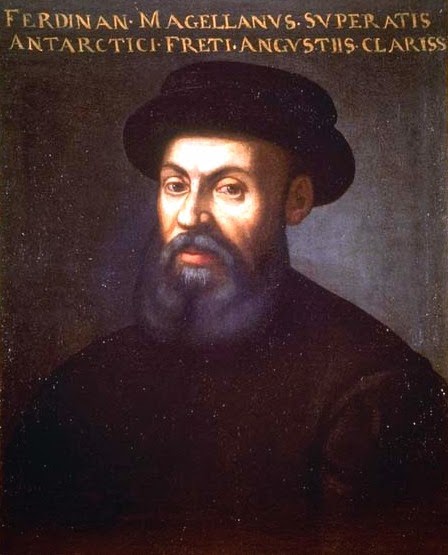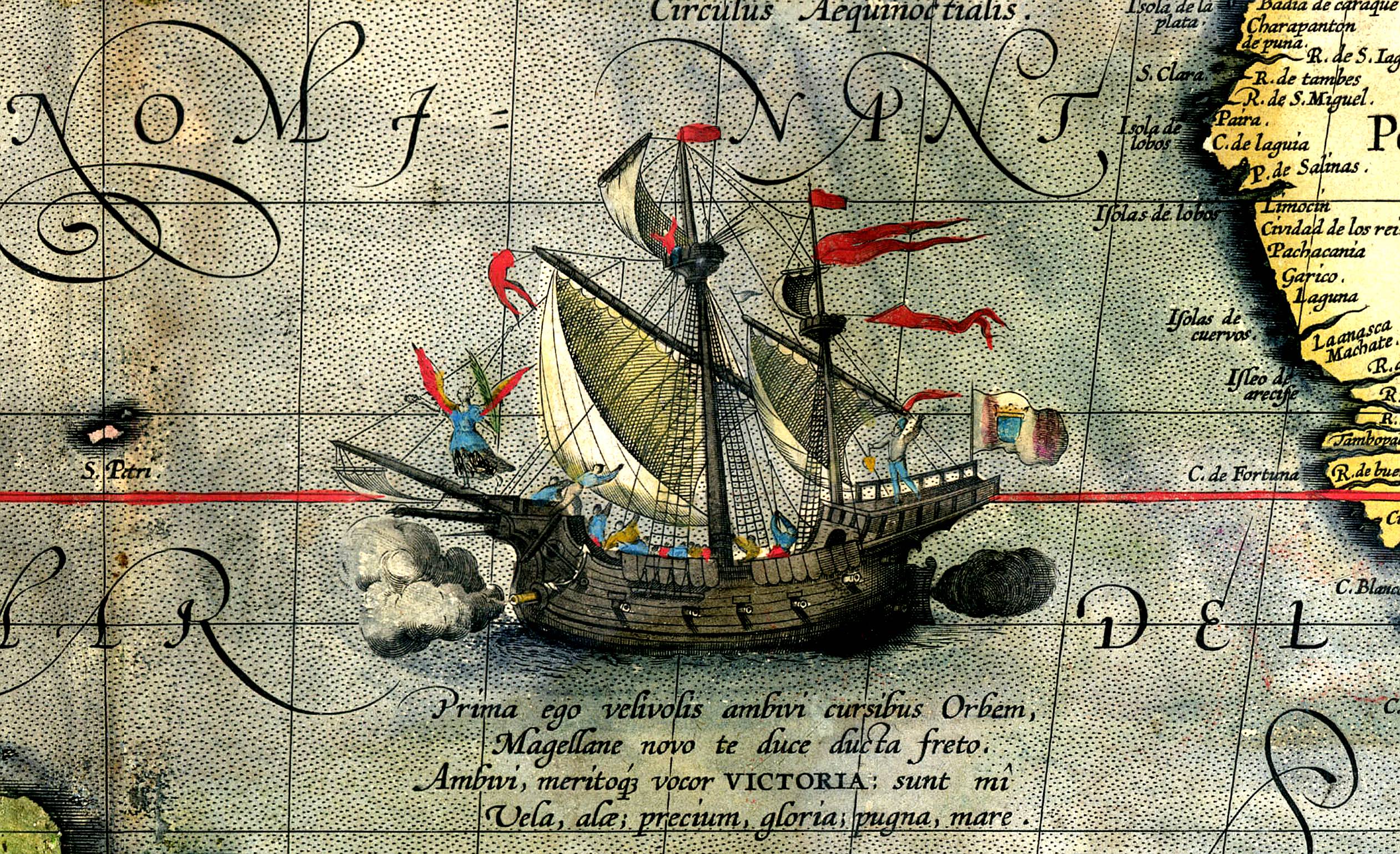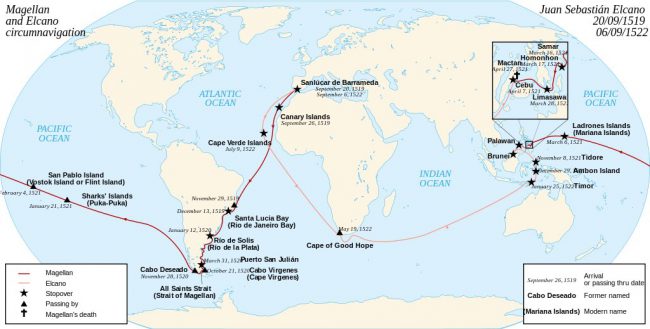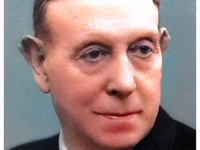
Ferdinand Magellan (1480 – 1521)
On 10 August 1519, five ships under Portuguese explorer Ferdinand Magellan‘s command left Seville and descended the Guadalquivir River to Sanlúcar de Barrameda, at the mouth of the river. After further preparation 5 weeks later the ships set sail for the very first circumnavigation of the earth.
Growing up in Lisbon
Magellan was born Fernão de Magalhães (or Magalhãens) to an impoverished noble family in the northern Portuguese province of Trás-os-Montes. His father, Rui de Magalhães, was mayor of his home village Sabrosa. His mother was Alda de Mesquita. When he was ten years old, Magellan lost his parents. In 1492, like his brother before him, he went to the royal court of King John II of Portugal and Queen Eleonora as a page. Here, in Lisbon, together with his cousin Francisco Serrão, he enjoyed a comprehensive education, possibly by Martin Behaim, and was raised to the rank of squire in 1496.
Expeditions to India and Malacca
In 1505 he participated in the India expedition of the viceroy Francisco de Almeida, where he distinguished himself as a lifesaver and prevented a mutiny. Under Afonso de Albuquerque he took part in the conquest of the important port of Malacca, now Malaysia, in 1511 and played an important role in the storming of the city on 10 August. In December 1511, an expedition of three ships under the command of António de Abreu sailed on to the Spice Islands. According to a source, Magellan was among the 100-man crew and was appointed captain during the expedition. A short time later, however, Magellan lost his captain’s post again because he had sneaked away from the fleet with his ship and sailed further east.
Fighting in Morocco , Disgrace in Portugal, Service for Spain
On his return he was sent to Morocco in 1513, where he fought in the Battle of Azamor and was wounded at the knee. Because of illegal trade with the Moors, he fell out of favour with King Manuel I and was released from Portuguese civil service on 15 May 1514. Thereupon he went to Spain and offered his services in 1517 to the Spanish King Charles I (from 1519 as Charles V Emperor of the Holy Roman Empire).
In Search for the Spice Islands
Magellan had probably found a secret map in the Portuguese Maritime Archives which indicated that a paso, a passage to the Pacific Ocean, existed in South America. It is possible that the large estuary delta of the Río de la Plata had been misconstrued as a strait. He decided to be the first to use this path to the west to reach the Spice Islands (today’s Moluccas). They were a strategically important starting point for the lucrative spice trade. Moreover, Magellan was convinced that, according to the Treaty of Tordesillas of 1494, the Spice Islands were located on the world half promised by Pope Spain.[4] On 22 March 1518 he signed a contract in Valladolid with Charles I of Spain, who provided Magellan with five ships with which he was to find the Spice Islands.
Starting for a Trip around the World
The provided fleet consisted of five ships of which the flagship Trinidad sailed under Ferdinand Magellan’s command. The crew consisted of 270 men across the continent and took off on August 10, 1519. The ships sailed from Seville down the Guadalquivir, at its mouth near Sanlúcar de Barrameda, where the Spanish authorities tried to prevent the Portuguese admiral from travelling for more than five weeks. It was not until September 20, 1519 that the fleet set sail from here. On his flagship, the Trinidad, Magellan had a torch installed at night so that the other ships could maintain visual contact. Magellan sailed first to the Canary Islands, where he took up supplies in Tenerife on 26 September, and then to the Cape Verde Islands (3 October), where he set course for Brazil. On November 20th, his fleet crossed the equator. On December 6, the fleet reached the South American coast, where it anchored on December 13 in a bay named by Magellan as Bahia de Santa Lucía (now Guanabara Bay) – after the day saint Santa Lucia. The Portuguese later gave it the name of St. Januarius. It is today’s bay of Rio de Janeiro.

Magellan’s ship Victoria, detail from a world map by Abraham Ortelius, 1590
Reaching the South Sea
On March 30, the fleet reached a bay called Puerto San Julián. As the southern winter was approaching, Magellan decided to hibernate. Because of running out of supplies, he had his food rations cut. Already on April 1, the poor supply situation led to a mutiny. Due to hunger, disease and exhaustion, some crew members demanded their return to Spain. In October 1520 the four ships left Puerto San Julián after seven months of winter quarters. Again all bays and estuaries were searched in detail for the paso. On October 21, 1520, Magellan reached a cape he called Cabo Vírgenes. The Concepción and the San Antonio were sent on a reconnaissance trip south of the cape and discovered the entrance to the long sought-after passage. Before the passage, Magellan asked the captains of the other ships whether they favoured a continuation of the voyage or a return. No one except the pilot of the San Antonio dared to recommend a change. Since the passage is divided several times, a boat and two ships were sent out for exploration. From the crew of the boat came the message that the road had an exit to the northwest: The South Sea was reached.
The Island of Thieves
The fleet continued and in early 1521 they reached the equator and later Guam. The cities they traveled to were named by Magellan according to the features he observed. For instance he renamed the island to the ‘Island of Thieves‘ since his small boats on board of the Trinidad were stolen.

The Magellan–Elcano voyage. Victoria, one of the original five ships, circumnavigated the globe, finishing 16 months after Magellan’s death.
The Philippines and a Poisoned Arrow
After taking up much-needed supplies, Magellan’s fleet sailed on to the Philippines. At that time, 150 sailors were still alive. With the help of his interpreter Enrique Melaka, Ferdinand Magellan was able to exchange gifts with the Prince of Limasawa, Raja Kolambu, who led the Spaniards to the island of Cebu, where they succeeded in converting the prince of Cebu, Rajah Humabon, and many of his subjects to Christianity. The chief Lapu-Lapu on the neighbouring island of Mactan, however, rejected the idea of supremacy and missionary work. As a result, Magellan tried to take possession of the island by force for his ally and thus for Spain and Christianity. The military action on Mactan on 27 April 1521 failed: despite their firearms, the Spaniards were pushed back on the shore by the locals and had to mourn several casualties. Magellan was killed in that battle. According to the reports of his chronicler Pigafetta, he was one of the last to fight in the water to cover the retreat of his people. A poisoned arrow had pierced his thigh; shortly thereafter he had been struck down by two lance shots, one wounding him in the face, the other under his right arm. Soon after the failed attack on Mactan, the prince of Cebu renounced Christianity and lured the Europeans into a trap. 35 sailors were killed.
Elcano Finishing the Journey
The Spaniards barely escaped, but they were now so few that they sank the Concepción themselves and distributed the survivors to Trinidad and Victoria. Juan Sebastián Elcano captained the Victoria and Gonzalo Gómez de Espinosa the Trinidad. Elcano had been chosen captain, although he had only been a simple bosun at the beginning of the voyage. They began their journey home with the flagship and the Victoria, arriving in September, 1522. Through interviewing some of the survivors, Europe learned about the first circumnavigation of the globe. Also during this journey, the crew observed numerous animals that were completely new to Europeans. Afterwards, several straits and locations were named after Ferdinand Magellan and even craters on the Moon and Mars have been named after him.
Aftermath
Since the 19th century, Ferdinand Magellan’s name has been associated primarily with the first historically documented circumnavigation of the Earth. However, Magellan neither circumnavigated the earth himself, nor did he ever plan to do so – even if his companion and admirer Antonio Pigafetta claimed he did. But Pigafetta’s statements about Magellan are clearly written with apologetic intent, that is, he wanted to defend the reputation of his late boss against his enemies and critics. In the documents from the planning phase of the expedition, there is not a single indication that Magellan or anyone else had planned a circumnavigation of the earth at that time. In the end, this came about only out of necessity, because Juan Sebastián Elcano, the last captain of the Victoria, and his crew hoped to bring their worn-out ship with its valuable spice cargo back to Spain this way – which they eventually succeeded in doing. Consequently, Elcano and his crew first reaped the glory of being the first humans to circumnavigate the earth. Since every educated contemporary at the time knew that the earth was a sphere, the voyage of the Victoria was seen not so much as proof of the spherical shape as of the superiority of their own time, in which they lived, over antiquity. Before the 19th century, little of this fame fell on Magellan. While his Spanish patrons did not hold him in particularly high esteem either during his lifetime or afterwards, his Portuguese compatriots reviled him as a traitor. However, his seafaring and military achievements were certainly recognized – especially the discovery and passage of the strait between South America and Tierra del Fuego, known as the “Estrecho de Magallanes” (Strait of Magellan) from around the middle of the 16th century.
However, subsequent expeditions – notably that of García Jofre de Loaísa in 1525, in which Elcano also participated – showed that the practical value of the sea route to the Pacific and on to Asia found by Magellan was very small. The passage of the Strait of Magellan was a gamble, and the Pacific Ocean was not only immensely large, but made it impossible to establish lasting trade and dominion relations as long as it could only be crossed from east to west. The opposite direction was not achieved until 1565, when Andrés de Urdaneta succeeded in making his way back from the Visayas to Mexico by sailing far out into the North Pacific and taking advantage of the prevailing westerly winds there. Only now were the Spaniards able to colonize the Philippines (soon to be called the Philippines).
Dr. Gallup-Diaz, Great Voyages: Ferdinand Magellan, ‘Our One True Guide’: The First Circumnavigation of the Globe [6]
References and Further Reading
- [1] Magellan at Britannica
- [2] Stefan Zweig (2007), Conqueror of the Seas – The Story of Magellan
- [3] The Voyage of Ferdinand Magellan
- [4] How the Pope divided the New World among Spain and the Rest of the World, SciHi Blog
- [5] Juan Sebastián Elcano and the First Circumnavigation of the Earth, SciHi Blog
- [6] Dr. Gallup-Diaz, Great Voyages: Ferdinand Magellan, ‘Our One True Guide’: The First Circumnavigation of the Globe, Penn Museum @ youtube
- [7] Primera vuelta al mundo Magallanes-Elcano – V Centenario, official Spanish website for the 500th anniversary of the first circumnavigation of the earth
- [8] Antonio Pigafetta: Magellan’s voyage around the world. 3 vol. Ed. by James Alexander Robertson, Cleveland (Ohio), 1906.
- [9] Antonio de Herrera y Tordesillas: Historia general de los hechos de los castellanos en las islas y tierra firme del mar océano. Madrid 1601.
- [10] Ferdinand Magellan at Wikidata
- [11] Timeline of 16th Century Explorers via DBpedia and Wikidata






Pingback: Whewell’s Gazette: Year 2, Vol: #38 | Whewell's Ghost
Pingback: Whewell’s Gazette: Year 03, Vol. #52 | Whewell's Ghost
Though Magellan is often credited with the first circumnavigation on the globe, he did so on a technicality: He first made a trip from Europe to the Spice Islands, eastward via the Indian Ocean, and then later made his famous westward voyage that brought him to the Philippines. So he did cover the entire terrain, but it was not a strict point A to point A, round-the-world trip, and it was made in two different directions. His slave, Enrique, however, was born in either Cebu or Mallaca and came to Europe with Magellan by ship. Ten years later, he then returned to both Cebu (with Magellan) and Mallaca (after Magellan died) by ship on the armada s westward route. So Enrique was the first person to circumnavigate the world in one direction, from point A to point A.